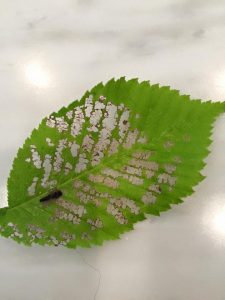The best time to treat elm leaf beetle is when your elm tree is just coming into leaf. The Elm Leaf Beetle(Xanthogaleruca luteola) is around 4-6mm long, olive and black with two stripes. The beetles feed on elm leaves in the tree canopy where they lay yellow eggs on the underside of the leaves. The eggs hatch as black and yellow caterpillars or larvae. The larvae feed on the green tissue of the underside of the leaf. The larvae then crawl down the trunk and pupate in bark cracks or around the base of the tree. The pupate emerge as adult beetles and return to the foliage to continue the cycle of destruction.

Skeletonisation a sure sign of elm leaf beetle
Signs of elm leaf beetle damage
- Damage to leaves between October and February
- Shot holes in the leaves caused by beetles
- Skeletonisation caused by larvae
- Defoliation out of season
Prevention
- Remove dead limbs and suckers
- Minimize drought stress to improve resistance
- Keep elm trees watered in dry periods
- Fertilise in spring with slow-release fertiliser
- Mulch around tree
Treatment
The Elm Leaf Beetle can’t be eradicated but it can be managed. Early treatment is essential and can include:
- Trunk injection with Imidacloprid* is considered to be the most effective and environmentally sound option for tree trunks >200mm. The insecticide is injected into the trunk of the tree where it travels to the leaves. The beetles only need to eat a small amount of leaf for the chemical to kill them; you will see evidence of dead and dying beetles around the tree base. This process is safe around children, pets and riparian situations.
- You can use a canopy foliar spray on young small trees towards the end of October where you are able to reach all around the tree. This needs to be done annually.
- Non-chemical control banding is a non-chemical approach that can help break the cycle by trapping larvae as they migrate down the trunk between December and early February. Wrap adhesive tape sticky side out around the trunk in a 20cm wide strip. While this method is environmentally safe, it may not be effective against heavy infestations.
TreeWorks does not recommend:
- It requires up to 100 L of water per tree and is not recommended when soil moisture is low.
- The chemical is taken by the feeder roots and fed through the tree’s vascular system to the shoots and leaves where it will kill the adult beetle and the larvae.
- Injections need to be carried out around 6-8 weeks prior to the beetles emerging from hibernation.
- It’s harmful to soil flora and fauna, including earthworms and mycorrhiza.
- Applications near creeks and rivers or near food gardens pose particular risks for invertebrates and human health as it will kill everything in the soil.
Timing
TreeWorks is a leading tree services business operating in Canberra, Monaro, and Southern Tablelands. We are a fully licensed, ACTEW accredited & insured tree surgery company and a member of Arboriculture Australia. Our climbers are appropriately trained and some of our arborists have over 25 years experience in large scale tree surgery and removals. Call 1800 873 343 or book online for a free on-site tree health and safety inspection. information.
